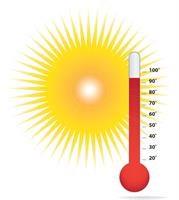It’s a Hot One Out There! How to Avoid Heat-Related Illnesses
June 2017

As we enter the summer months, it is important that workers are aware of the risk of heat-related hazards and injuries. Those who are at the greatest risk of heart stress are generally over the age of 65, have a heart-related medical condition, are overweight and have high blood pressure. The summer months are the portion of the year that nearly everyone looks forward to most; however, with the increased temperature comes an increased risk for people experiencing heat-related illnesses. Heat-related illnesses include a variety of conditions that arise from exposure to high-temperatures, direct sunlight, humidity and lack of hydration. Heat stroke, heat exhaustion and heat cramps and the most serious forms of heat-related illness. Each of these conditions is caused by exposure to heat and carries with it a variety of symptoms.
Heat stroke occurs when the body loses the ability to properly maintain a normal core body temperature. During heat stroke, the body’s temperature can rise to levels as high as 106° F and may result in fatality or permanent disability without proper medical treatment. Symptoms of heat stroke include hot, dry skin, profuse sweating, hallucinations, chills, headaches, confusion and slurred speech.
Heat exhaustion is the body’s response to large losses of water and salt from sweating. A worker experiencing heat exhaustion has similar symptoms as heat stroke. If a worker is suspected of having heat stroke or heat exhaustion, 911 should be called immediately to provide proper medical care.
Heat cramps, like heat exhaustion, are caused by losing large amounts of water quickly which results in painful muscular cramps. Although this condition is less severe than heat stroke and heat exhaustion, it is uncomfortable and still requires the employee to be removed from the hot environment and begin rehydrating with fluids. A worker experiencing heat cramps should not return to work for a few hours after the cramps subside.
Preventative measures to reduce and control the frequency of heat-related illness should be discussed and reviewed with your team at the beginning of the warm season. Preventative measures include:
1) Selecting appropriate clothing that will keep the body cool. Light colored, loose-fitting, cotton (or other breathable material) should be worn.
2) Begin hydration before outdoor work and repeat often. Drink enough water so that thirst is not experienced. Drinking about 1-cup of water every 15-20 minutes will help prevent dehydration.
3) While working outdoors, take breaks often while the body adjusts to the heat.
4) Pay attention to weather reports and schedule work around cooler parts of the day.
5) Stick to the Buddy System. It’s essential to monitor your own physical condition as well as that of your coworkers. Having a designated person check in with workers to monitor signs and symptoms of heat related illness and provide cool water will help to reduce the frequency and severity of heat related illness.
Sources:
https://www.cdc.gov/niosh/topics/heatstress/default.html
http://www.accuweather.com/en/weather-news/prolonged-exposure-to-heat-cho/26887488
https://www.osha.gov/pls/oshaweb/owadisp.show_document?p_table=NEWS_RELEASES&p_id=26052
http://www.cdc.gov/niosh/topics/heatstress/
https://www.osha.gov/SLTC/heatstress/heat_illnesses.html
Related Topics: Did you know, Short Read